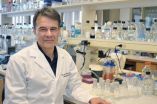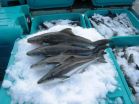(Press-News.org) UPTON, NY - By measuring how strongly electrons are bound together to form Cooper pairs in an iron-based superconductor, scientists at the U.S. Department of Energy's (DOE) Brookhaven National Laboratory, Cornell University, St. Andrews University, and collaborators provide direct evidence supporting theories in which magnetism holds the key to this material's ability to carry current with no resistance. Because the measurements take into account the electronic bands and directions in which the electrons are traveling, which was central to testing the theoretical predictions, this research strengthens confidence that this type of theory may one day be used to identify or design new materials with improved properties - namely, superconductors operating at temperatures far higher than today's.
The findings are published in the May 4, 2012 issue of Science.
"In the best possible world you would be able to take this theory and plug in different chemical elements until you find a combination that should work as a superconductor at higher temperatures," said team leader Séamus Davis, Director of the Center for Emergent Superconductivity (http://www.bnl.gov/energy/ces/) at Brookhaven and the J.G. White Distinguished Professor of Physical Sciences at Cornell University. Such materials could be used for real world, energy-saving technologies, such as zero-loss power transmission lines, without the need for expensive coolants.
Scientists have been trying to understand the mechanism underlying so-called "high-temperature" superconductivity ever since discovering materials that could carry current with no resistance at temperatures somewhat above the operating realm of conventional superconductors, which must be chilled to near absolute zero (0 kelvin, or -273° Celsius). Though still mighty chilly, these high-Tc materials' operating temperatures - some as high as 145K (-130°C) - offer hope that such materials could one day be designed to operate at room temperature.
One key to superconductivity is the formation of electron pairs. Scientists hypothesized that if these negatively charged particles have their magnetic moments pointing in opposite directions, they could overcome their mutual repulsion to join forces in so-called Cooper pairs - thus carrying current with no loss.
"Many people suspected you could take materials that naturally have alternating magnetic moments on adjacent electrons - antiferromagnetic materials - and convert them into superconductors," Davis said. But to prove this conjecture hasn't been possible with copper-based, or cuprate, superconductors - the first high-Tc superconductors discovered starting some 25 years ago. "You can make a robust antiferromagnetic cuprate insulator, but in that state it's hard to get the magnetic electrons to pair and then move around and make a superconductor," Davis said.
Then, in 2008, when iron-based superconductors were discovered, the idea that magnetism plays a role in high-Tc superconductivity was revived. But determining that role was a very complex problem.
"In each iron atom there are five magnetic electrons, not just one," Davis said. "And each, as it moves around the crystal, does so in a separate electronic band. In order to find out if the magnetic interactions between electrons are generating the superconductivity, you have to measure what's called the anisotropic energy gap - how strongly bound together the electrons are in a pair - depending on the electrons' directions on the different electronic bands."
Theorists Dung-Hai Lee of the University of California at Berkeley, Peter Hirschfeld of the University of Florida, and Andrey Chubukov of the University of Wisconsin among others had developed different versions of a theory that predicts what those measurements should be if magnetism were the mechanism for superconductivity.
"It was our job to test those predictions," Davis said. But at first, the techniques didn't exist to make the measurements. "We had to invent them," Davis said.
Two scientists working with Davis, Milan P. Allan of Brookhaven, Cornell, and the University of Saint Andrews (where Davis also teaches) and Andreas W. Rost of Cornell and St. Andrews - the lead authors on the paper - figured out how to do the experiments and identified an iron-based material (lithium iron arsenide) in which to test the predictions.
Their method, multi-band Bogoliubov quasiparticle scattering interference, found the "signature" predicted by the theorists:
"The strength of the 'glue' holding the pairs together is different on the different bands, and on each band it depends on the direction that the electrons are traveling - with the pairing usually being stronger in a given direction than at 45° to that direction," Davis said.
"This is the first experimental evidence direct from the electronic structure in support of the theories that the mechanism for superconductivity in iron-based superconductors is due primarily to magnetic interactions," he said.
The next step is to use the same technique to determine whether the theory holds true for other iron superconductors. "We and others are working on that now," Davis said.
If those experiments show that the theory is indeed correct, the model could then be used to predict the properties of other elements and combinations - and ideally point the way toward engineering new materials and higher-temperature superconductors.
INFORMATION:
This research was supported as part of the Center for Emergent Superconductivity, an Energy Frontier Research Center funded by the U.S. Department of Energy, Office of Science; the U.K. Engineering and Physical Sciences Research Council; the U.S. National Science Foundation; the Japan Society for the Promotion of Science; the Academia Sinica Research Program on Nanoscience & Nanotechnology; and a Royal Society Wolfson Research Merit Award.
DOE's Office of Science is the single largest supporter of basic research in the physical sciences in the United States, and is working to address some of the most pressing challenges of our time. For more information, please visit http://science.energy.gov/.
One of ten national laboratories overseen and primarily funded by the Office of Science of the U.S. Department of Energy (DOE), Brookhaven National Laboratory conducts research in the physical, biomedical, and environmental sciences, as well as in energy technologies and national security. Brookhaven Lab also builds and operates major scientific facilities available to university, industry and government researchers. Brookhaven is operated and managed for DOE's Office of Science by Brookhaven Science Associates, a limited-liability company founded by the Research Foundation of State University of New York on behalf of Stony Brook University, the largest academic user of Laboratory facilities, and Battelle, a nonprofit, applied science and technology organization.
Visit Brookhaven Lab's electronic newsroom for links, news archives, graphics, and more at http://www.bnl.gov/newsroom , or follow Brookhaven Lab on Twitter, http://twitter.com/BrookhavenLab .
END
Intertops Casino players will be climbing Mount Olympus this month to claim their place with the Gods - and win a share of the $70,000 in casino bonus money and cash prizes to be awarded in May.
Buy! Sell! Spin! Intertops Casino customers can now enjoy Bulls and Bears, a new stock market-themed slot game where wild Bull and Bear symbols double the prize and quadruple winnings when they appear together in a winning combination. The Feature Guarantee system ensures that the bonus game is triggered regularly and loads of free spins give a great return on investment.
As ...
Baltimore, MD — Insect glands are responsible for producing a host of secretions that allow bees to sting and ants to lay down trails to and from their nests. New research from Carnegie scientists focuses on secretions from glands in the reproductive tract that help sperm survive and guide the sperm on the trip to fertilize an egg. The gene that controls the development of these glands in fruit flies provides important information about gland development in all insects, as well as potential clues to similar human reproductive glands. Their work is published this month in ...
Reston, Va. (May 3, 2012) – The use of single positron emission computed tomography (SPECT)/computed tomography (CT) has been reported to change clinical management in a significant number of thyroid cancer patients according to research presented in the May issue of The Journal of Nuclear Medicine. Information obtained from these scans not only helps determine the need for radioiodine therapy or alterative options, but also impacts the long-term follow-up strategy.
"In this article I aimed to highlight the role of radioiodine imaging in risk stratification of patients ...
Philadelphia, PA, May 9, 2012 – Shop the perimeter and avoid center isles, don't buy anything at eye level, investigate the label. Grocery shopping can be a daunting task. Moreover, studies have shown that Americans obtain most of their food from grocery stores and their shopping habits are predictive of their consumption of fruits, vegetables, and sugared soft drinks. Many grocery stores are taking an active role in helping consumers make healthful food choices. You may have even seen your grocery store use a nutritional score placed right on the shelf's price label ...
LONDON, ON - In a new study from Lawson Health Research Institute, Dr. Joseph Torchia has identified a new genetic pathway influencing the spread of cancer cells. The discovery of this mechanism could lead to new avenues for treatment.
Regular cell division is regulated by methylation, a series of chemical changes. Methylation modifies DNA to ensure cells divide at a healthy, balanced rate. In cancer, the methylation process is unbalanced, causing cells to resist regulation and divide uncontrollably.
Research suggests changes in genetics play a role in this process, ...
There are two federal laws regarding breast augmentation surgery. The first, passed in 2000, states that it is illegal for anyone under the age of 18 to have breast augmentation surgery unless such surgery is for legitimate medical or reconstructive purposes. The second, passed in 2006, states that it is illegal for anyone under the age of 22, even in instances of necessary reconstruction, to have silicone breast implants placed. This means, legally, you need to be 18 to get breast implants and 22 if you'd prefer silicone implants.
The reasons behind these laws are relatively ...
Stephanie Woodward, a second-year student at Syracuse University College of Law and a research assistant with the Burton Blatt Institute (BBI) at SU, has been selected as the inaugural recipient of the Olinsky Law Group/Burton Blatt Institute Fellowship. The fellowship was established through a generous gift from disability law attorney Howard D. Olinsky L'85, a member of BBI's Board of Advisors and its executive committee.
"The fellowship will provide invaluable practical experience each academic year for a law student interested in the field of civil rights law. ...
CAMBRIDGE, Mass. — The flexible properties of hydrogels — highly absorbent, gelatinous polymers that shrink and expand depending on environmental conditions such as humidity, pH and temperature — have made them ideal for applications from contact lenses to baby diapers and adhesives.
In recent years, researchers have investigated hydrogels' potential in drug delivery, engineering them into drug-carrying vehicles that rupture when exposed to certain environmental stimuli. Such vesicles may slowly release their contents in a controlled fashion; they may even contain more ...
Astronomers from Queen's University Belfast have gathered the most direct evidence yet of a supermassive black hole shredding a star that wandered too close. The Queen's astronomers are part of the Pan-STARRS international team, whose discovery has been published in the journal Nature today (Wed, 2 May).
Supermassive black holes, weighing millions to billions times more than the Sun, lurk in the centers of most galaxies. These hefty monsters lie quietly until an unsuspecting 'victim', such as a star, wanders close enough to get ripped apart by their powerful gravitational ...
When it comes to the food used to raise fish in aquaculture "farms," it seems that you may get what you pay for. In a new study,* researchers from the National Institute of Standards and Technology (NIST) and the South Carolina Department of Natural Resources (SCDNR) looked at the health effects of raising farmed fish on a diet incorporating less than the usual amount of fishmeal—a key but expensive component of current commercial fish food products. They learned that reduced fishmeal diets may be cheaper, but the fish were less healthy.
Commercial aquaculture is one ...


